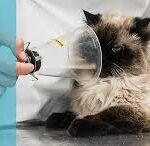EatChicken feet might not be the prettiest Dog treat, but they are worth a second look, as they offer valuable health benefits for our canines. Chicken feet are naturally rich in glucosamine and chondroitin, which are both known to support the joint health and mobility of dogs and cats. In addition, chicken feet can act as edible and fully digestible toothbrushes, supporting gum and dental health.
Table of Contents
Aren’t Chicken Bones Dangerous for Dogs?

Most of us have at least once received the well-intended advice never to give chicken bones to a dog. No matter how often repeated, this advice is only partially correct. Indeed, the bones of cooked, boiled, or fried chicken should not be given to a dogs. The high cooking temperatures turn chicken bones into hard, glass-like structures, which break into sharp and pointy splinters if dogs chew on them. These splinters can cause serious injuries.
Raw or dehydrated (dried) chicken bones are both considered safe. In contrast to cooked chicken bones, their texture is rather soft and brittle. When chewed, they will crush but not break into pointy objects. They are fully digestible for pets.
Besides some tiny bones, chicken feet mostly consist of skin, connective tissue, and cartilage. This is what makes them easily digestible. This also includes their nails. If you feel uncomfortable about them, clip them off.
Benefits of Chicken Feet for Dogs:
Chicken feet are naturally rich in protein, glucosamine, and chondroitin. While protein is an important source of energy that should, according to the National Research Council, account for 10% of the diet by weight of an adult dog, the most interesting nutrients of chicken feet are glucosamine and chondroitin. Both natural compounds are building blocks of cartilage and connective tissue.
Arthritis, Joint Health and Mobility of Dogs

Countless studies over the last few decades have shown the powerful positive effects of the oral supplementation of glucosamine and chondroitin on joint health, arthritis, and, consequently, the overall mobility of dogs and cats. In fact, if your dog is suffering from arthritis, there is a high likelihood that your veterinarian will recommend glucosamine and chondroitin to treat your pet.
If you prefer to give your dog natural sources of glucosamine and chondroitin rather than in pill form, consider chicken feet. Based on studies, each chicken foot has about 450 mg of glucosamine. This makes them one of the cheapest sources of arthritis treatment for pets.
Dental Health of Dogs:
Dental disease is the most common disease in dogs, affecting 76% of all canines in the United States. Since 2006, there has been a 23.3% increase in the prevalence of dental disease in dogs, with steady growth each year.
Dental care is important for dogs. Otherwise, it can lead to bad breath and, if left untreated, can be a source of infection for illness affecting the heart, liver, and kidney. One way to ensure the dental health of our canines is the regular brushing of their teeth. This should ideally be done daily, using special toothpaste for dogs.
If brushing your pet’s teeth is not your thing, or your dog will not tolerate it, then try giving them chicken feet instead. When dogs chew on them, this process will naturally remove plaque and tartar build-up on their teeth.
Chicken feet are not only good for joint pain but also improve your dog’s teeth and gum health.
How Many Chicken Feet Should I Give to My Dog?
Depending on the diet and the size of your dog, we recommend giving them between one to three feet per day. Please always observe your dog when feeding any chews. Also, ensure that your canine has access to plenty of fresh water.
Finally, please always seek the advice of a holistic veterinarian on how to best supplement your dog’s diet with new ingredients and treats. We also always recommend practising variation, moderation, and balance when introducing new foods or treats to your canines.





























































